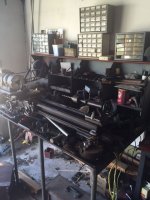Committed to purchase this 9A, part of an estate sale- from these two pictures. Estate trustee doesn't know anything about it (other, than owned by his now departed 99 year old uncle); wanted it gone and comes with everything related to it. Hard to tell from the pics all that's there, but I see two chucks on the bench (hoping that smaller one is a 4-jaw but I can't tell). Who knows what other "goodies" (or, junk) might be there- really hoping to find the steady for it.


He said it runs, and from the pics doesn't look beat-up- but the price reflects the "unknown" factor. My eyeballs tell me it's gotta be the 4' or 4-1/2' bed model, and not smaller (I hope, or there won't be enough between centers).
I'm hoping for some help in two areas...
First, gotta get this back to my shop. I known it's a relatively light lathe- but at 400 lbs is still more than my son and myself can handle. I was thinking about buying a one-ton foldable shop crane from HF: 1 Ton Capacity Foldable Shop Crane
This would also allow loading (I think) into the bed of my 3/4 ton pickup. Other than trying to source manpower, this is the only idea I've had- but don't see a problem with it. No other use for a shop crane, but seems it would be a requirement for having only two backs available (one of which isn't in great shape!)
Feasible to rig the lathe to this via the bedways? How difficult is it to uncouple the drive motor assembly? Better solution to moving it?
Then, after the move, I need to learn all I can about this old chunk of American iron. A steady is needed, if there isn't one there, does anyone still make them- or is it "Ebay time"? Assuming I haven't bought a money pit, I'd love to restore it to her former glory as time permits- sources for information on this (original manual copies?), and parts?
Appreciate any advice on moving- and insight into the 9A. Thanks!


He said it runs, and from the pics doesn't look beat-up- but the price reflects the "unknown" factor. My eyeballs tell me it's gotta be the 4' or 4-1/2' bed model, and not smaller (I hope, or there won't be enough between centers).
I'm hoping for some help in two areas...
First, gotta get this back to my shop. I known it's a relatively light lathe- but at 400 lbs is still more than my son and myself can handle. I was thinking about buying a one-ton foldable shop crane from HF: 1 Ton Capacity Foldable Shop Crane
This would also allow loading (I think) into the bed of my 3/4 ton pickup. Other than trying to source manpower, this is the only idea I've had- but don't see a problem with it. No other use for a shop crane, but seems it would be a requirement for having only two backs available (one of which isn't in great shape!)
Feasible to rig the lathe to this via the bedways? How difficult is it to uncouple the drive motor assembly? Better solution to moving it?
Then, after the move, I need to learn all I can about this old chunk of American iron. A steady is needed, if there isn't one there, does anyone still make them- or is it "Ebay time"? Assuming I haven't bought a money pit, I'd love to restore it to her former glory as time permits- sources for information on this (original manual copies?), and parts?
Appreciate any advice on moving- and insight into the 9A. Thanks!

